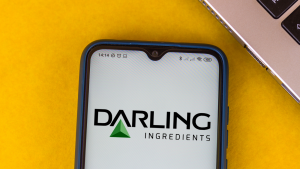7 Consumer Staples Stocks to Buy at a 52-Week Low in July
For the last two years, investors in consumer staples stocks saw every tiny step forward smacked down by two large steps back. Therefore, the 900+-point gain in the Dow Jones Industrial Average (DJIA) the week of July 15 was noteworthy. It suggested that the long-awaited “sector rotation” was finally underway.
Over the past two years, the dual impact of high inflation and interest rates has affected consumers. As businesses lost their pricing power, it was easier for investors to focus on the fast-growing technology sector. Not surprisingly the market gains have been heavily concentrated in big technology stocks.
But the market is forward thinking. And institutional investors are expecting lower interest rates perhaps as early as September. That’s put them on the hunt for stocks and sectors that are undervalued. One likely area is consumer staples. These stocks have been underperforming the market with some trading at or near their 52-week lows.
That means there’s an opportunity for many of these stocks to play catch-up as the market continues to broaden out. Here are seven consumer staples stocks that appear to be strong candidates for a bullish reversal.
Kenvue (KVUE)

One sign that consumers are under increasing financial stress is the news that they are opting for store (house) brands over name brands. This wasn’t the case when inflation first surfaced, and it indicates that even companies that sell consumer staples are losing pricing power.
That would affect a stock like Kenvue (NYSE:KVUE). The Johnson & Johnson (NYSE:JNJ) spinoff is the home of iconic consumer brands such as Band-Aid, Listerine, and Tylenol.
The stock has only been trading publicly since May 2023. That means year-over-year comparisons are just becoming available. In the last two quarters, Kenvue has beat earnings estimates, but the company has missed on the top line.
As a reflection of those misses, KVUE stock is down more than 14% in 2024 and hit a 52-week low in early July. But if consumers get relief from inflation, this could be a buyable dip. The consensus price target of 13 analysts is $21.72 which would be a 17% gain in the stock price. And by virtue of its parent company, Kenvue is already a dividend aristocrat with a dividend that yields over 4%.
Monster Beverage (MNST)

Normally, I would focus on consumer staples stocks that pay dividends. That’s not the case with Monster Beverage (NASDAQ:MNST). But it’s hard to look past the “monster” growth the manufacturer of energy drinks has been delivering.
In the last five years, MNST stock has delivered a total return of over 54%. But if you zoom out over 10, 15, and 20 years, you can see why many early investors have been repaid many times over.
But even great stocks take a breather and that’s what 2024 has been for Monster Beverage. MNST stock is down more than 10% but it’s not because of growth. The company continues to beat year-over-year revenue and earnings numbers.
But the stock was overvalued by many measures. Therefore, a healthy pullback was in order. However, investors confirmed support near its 52-week low in June and if Monster delivers a bullish full-year forecast when it delivers earnings in August, MNST stock may be ready for another bull run.
Lamb Weston (LW)

Lamb Weston (NYSE:LW) is another of the compelling consumer staples stocks trading near a 52-week low. Frozen potatoes are about as unexciting as you can get, but Lamb Weston stock has been a thrill for many investors since going public in 2016.
But like many staples plays, the stock is down 27% in 2024. The catalyst was a miss on earnings that was driven by the integration of a new ERP system in North America and softer restaurant traffic trends. That’s significant, because restaurant sales are the company’s largest market.
So far investors have rejected the stock’s 52-week low twice in the last month. However, investors who are thinking of getting involved may want to wait until the company reports earnings on July 24. At that time, the company will report its fourth quarter and full-year earnings for its fiscal year 2024. Weak guidance about restaurant sales may send LW stock lower. But if you’re looking for long-term value, this is one for the watch list.
Darling Ingredients (DAR)

The next three consumer staples stocks in this group are mid-cap stocks. This gives you an extra catalyst when you consider that in addition to investors rotating out of technology stocks there’s also activity in the mid-cap and small-cap space.
The first is Darling Ingredients (NYSE:DAR) which is a play on the growing sustainable economy. As I wrote earlier in July, Darling “…develops, produces and sells natural ingredients from edible and inedible bio-nutrients. For example, it converts animal byproduct streams into useable specialty ingredients,…”
This may sound like a niche industry, but the company has plenty of competition. That means the company faces pricing pressure that has pushed revenue, earnings and the DAR stock price lower. For example, it was lower earnings from Diamond Green Diesel (DGD), the company’s joint venture with Valero Energy (NYSE:VLO) that was largely responsible for the 50-cent earnings per share (EPS) miss in its most recent quarter.
Nevertheless, with DAR stock near its 52-week and four-year lows, analysts remain bullish. 10 out of 13 analysts give the stock a Strong Buy rating and the $55.93 price target suggests 47% upside.
Coty (COTY)

Coty (NYSE:COTY) is a cosmetics and skin care company that is the definition of a consumer staples company. This is typically an evergreen category. However, the company’s third quarter earnings report showed a concerning trend. That is the company continues to post year-over-year (YOY) revenue growth, but the bottom line is going the other way.
However, at least in the company’s most recent quarter, the miss on earnings was due, in part, to an equity swap. Okay, it was only responsible for a penny or two, but the company also cited gross margin expansion. A reason for that may be that the company is seeing strong growth in its prestige brands which includes Kylie Jenner’s beauty brand.
Trading at under $10 per share, COTY stock is within approximately 10% of its 52-week low. Investors may be skeptical about paying for a stock that’s trading at 42x earnings. But the forward P/E of 23x will make the stock more attractive if a more robust economy can turn around the earnings story.
Newell Brands (NWL)

Newell Brands (NASDAQ:NWL) is the last of the mid-cap’s on this list. The company is best known as the parent company for brands like Rubbermaid, Oster, and Coleman.
The company was one of the winners as the housing market exploded in 2020 and 2021. That makes sense. Whether you’re moving, putting things in storage, or accessorizing a new home, Newell had the products they needed. And if you weren’t moving, the company’s organizational products made it easier to love the home you had.
But purchases like that tend to be one-off’s and NWL stock is at five-year lows along with revenue and earnings. The stock does appear to be reasonably valued at around 10x forward earnings. And the company is doing its part by increasing its marketing spend.
However, the real growth will have to come when, and if, the consumer feels less pinched. If lower interest rates spur the housing market, Newell could be one to watch.
Medifast (MED)

Weight-loss stocks have rivaled AI stocks for the title of best-performing stocks in 2024. The launch of GLP-1 drugs to treat obesity has made a company like Medifast (NYSE:MED) seem so 2020. The company’s OPTAVIA brand focuses on building a healthy lifestyle that includes personal coaching and weight loss food products.
You can see why drugs such as Zepbound and Mounjaro would be a threat. That’s reflected in the company’s revenue and earnings which surged in 2020 and 2021 when people had time to commit to a weight loss plan. But with patients now having a shot to help with their weight-loss efforts, that trend has reversed in 2023 and continues today. And MED stock is down 71% in 2024 alone.
That said, Medifast is looking to incorporate GLP-1 drugs into its OPTAVIA program. Investors may get more information about the company’s efforts when it reports earnings in early August.
On the date of publication, Chris Markoch did not have (either directly or indirectly) any positions in the securities mentioned in this article. The opinions expressed in this article are those of the writer, subject to the InvestorPlace.com Publishing Guidelines.
On the date of publication, the responsible editor did not have (either directly or indirectly) any positions in the securities mentioned in this article.

